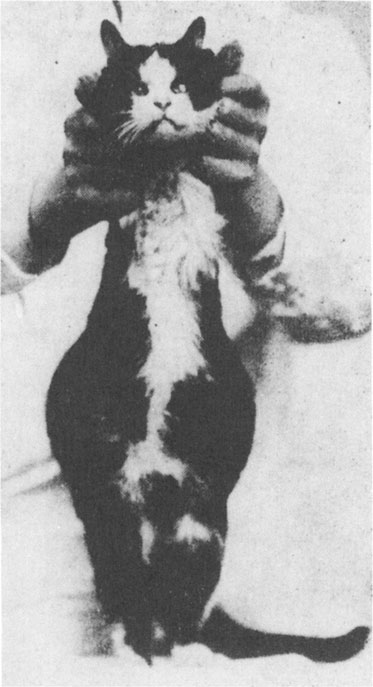Original article: Treatment of FIP in cats with Remdesivir
Richard Malik DVSc PhD FACVSc FASM
Until recently, the diagnosis of FIP for a feline patient was a death sentence. Although omega-interferon and polyprenyl immunostimulant had some effects in some cases, most cats and kittens diagnosed with FIP died or euthanasia was required due to poor condition.

That all changed a few years ago when the lifelong research of FIP Professor Niels C. Pedersen of UC Davis culminated. Niels first managed to save the lives of several cats with FIP with the protease inhibitor GC-376, and soon after showed that the nucleoside analog GS-441524 is even more effective in treating FIP, although the required dose depended on whether there was ocular or CNS involvement. . GS-441524 was a drug developed by the American company Gilead, which unfortunately did not show interest in further research into the molecule for veterinary use in the treatment of FIP. To fill the gap for effective FIP therapy, various companies have begun to manufacture GS-441524 and sell it on the black market. Although it was very expensive, the availability of quality GS-441524 provided determined cat owners with a way to save cats with wet or dry FIP, although obtaining this drug was complicated, usually associated with the help of a Facebook group. Unfortunately for cat lovers, APVMA and the Australian Veterinary Practitioner Board eventually made the import of GS-441524 and its use for veterinary purposes significantly more difficult, with repressive measures for veterinarians who wanted to help cats with FIP.
It is ironic that the COVID 19 pandemic has solved this problem. Gilead has developed remdesivir (GS-5734) for the treatment of human coronavirus disease. The drug received a temporary TGA marketing authorization in June 2020 for the treatment of SARS-Cov-2 infections in human patients. This process would normally take several years, but COVID accelerated it. Remdesivir is essentially GS-441524 with the addition of several additional phosphate groups to improve intracellular penetration (Figure 1B). Because remdesivir is an approved human drug, it can also be used off-label in veterinary practice, such as the treatment of FIP in cats. This circumvented problems with the use of an unlicensed medicine purchased on the black market and related problems with unproven efficacy, purity and consistency.

BOVA Aus was able to provide a reliable source of remdesivir. Studies in Australia have determined shelf life and confirmed in vitro efficacy against coronaviruses. We have been using it in clinical practice for the treatment of FIP for the last 6 weeks. Some of these cases were newly diagnosed cats, while others were cats that had already improved with GS-441524 obtained from the black market, which subsequently became unavailable. Several cases of wet and dry FIP have been treated. Even with the small number of cats, remdesivir appears to be very effective in treating FIP infections. Its subcutaneous administration is slightly easier compared to GS-441524, and it appears to be slightly less painful. It is supplied in a 100 mg vial, which is diluted with 9 ml of sterile water for injections to give a solution with a concentration of 10 mg / ml (10 ml vial after dilution).
In newly diagnosed cats with severe disease, we opted for the intravenous administration of remdesivir at a high starting dose (10 mg / kg dissolved in 10 ml saline and administered over 10 minutes) during the first 3 days of treatment, thus achieving a rapid onset of antiviral activity; The clinical signs of cats improved significantly during the initial therapy within 2-3 days. Cats then switch to subcutaneous treatment, usually at a lower dose. For common cases of FIP, we used 5-6 mg / kg once daily (SIUD) because remdesivir is thought to be approximately as effective as GS-441524 (Niels Pedersen, personal communication). In case of overt eye disease, a dose of 8 mg / kg SID is recommended and cats with neurological FIP with CNS symptoms are given 10 mg / kg SID. Treatment is then continued by daily subcutaneous injections for another 2-3 months. In cats for which SC injections were painful, we used gabapentin and / or buprenorphine for sedation / analgesia, and in some cases we introduced a new cephalic catheter every 5 days, which allowed the owners intravenous administration. In situations where owners could not afford the entire treatment, or when the injections were too painful, we used mefloquine (62.5 mg 2-3 times a week; obtained from BOVA or a local pharmacy) for initial work-based antiviral treatment after initial treatment with Remdesivir. Jacqui Norrisa and colleagues from the University of Sydney.
The main advantage of FIP Remdesivir treatment is that the active substance we use is present in an approved medicine for human use. It is just a matter of writing a prescription with the name and address of the client, the name of the patient and the dose to be administered. BOVA can usually prepare and deliver vials to any veterinarian in Australia within 24-48 hours. At present, the cost per 100mg vial is $ 250 plus GST and postage, although it is possible that the price will decrease over time due to larger orders. We believe that most owners will feel much better if they get the product from a well-known Australian company than to send money abroad and hope that black market drugs will get safely from China to Australia.
Veterinarians who want to know more about this treatment option or have general questions about FIP can contact me by email (richard.malik@sydney.edu.au). The diagnosis of FIP is beyond the scope of this newsletter, but effusive cats are most easily diagnosed by cytology and effusion analysis, followed by immunohistochemistry at VPDS, University of Sydney (easily arranged via Vetnostics, QML, ASAP, VetPath, Gribbles or IDEXX). Dry FIP is more problematic because it usually requires an accurate aspiration biopsy of pyogranulomatous lesions in the liver, kidneys, or abdominal lymph nodes. We found that 3 days of intravenous Remdesivir therapy could be used as a cost-effective therapeutic test in cats with dry FIP as an alternative to biopsy of intra-abdominal structures in exploratory laparotomy, as FIP cases rapidly improve most clinical symptoms. If veterinarians do not want to start treatment with Remdesivir themselves, we can recommend veterinarians interested in FIP treatment who would like to accept such cases.
Resources
Kim, Y .; Liu, H .; Galasiti Kankanamalage, AC; Weerasekara, S .; Hua, DH; Groutas, WC; Chang, KO; Pedersen, NC Reversal of the progression of fatal coronavirus infection in cats by a broad-spectrum coronavirus protease inhibitor. PLoS Pathog. 2016, 12, e1005531.
Pedersen, NC; Kim, Y .; Liu, H .; Galasiti Kankanamalage, AC; Eckstrand, C .; Groutas, WC; Bannasch, M .; Meadows, JM; Chang, KO Efficacy of a 3C-like protease inhibitor in treating various forms of acquired feline infectious peritonitis. J. Feline Med. Surg. 2018, 20, 378–392.
Murphy, BG; Perron, M .; Murakami, E .; Bauer, K .; Park, Y .; Eckstrand, C .; Liepnieks, M .; Pedersen, NC The nucleoside analog GS-441524 strongly inhibits feline infectious peritonitis (FIP) virus in tissue culture and experimental cat infection studies. Vet. Microbiol. 2018, 219, 226–233.
Pedersen, NC; Perron, M .; Bannasch, M .; Montgomery, E .; Murakami, E .; Liepnieks, M .; Liu, H. Efficacy, and safety of the nucleoside analog GS-441524 for treatment of cats with naturally occurring feline infectious peritonitis. J. Feline Med. Surg. 2019, 21, 271–281
Dickinson PJ, Bannasch M, Thomasy SM, et al. Antiviral treatment using the adenosine nucleoside analogue GS-441524 in cats with clinically diagnosed neurological feline infectious peritonitis. Journal of Veterinary Internal Medicine. 2020. doi: 10.1111 / jvim.15780.
McDonagh, P .; Sheehy, PA; Norris, JM Identification and characterization of small molecule inhibitors of feline coronavirus replication. Vet. Microbiol. 2014, 174, 438–447.








